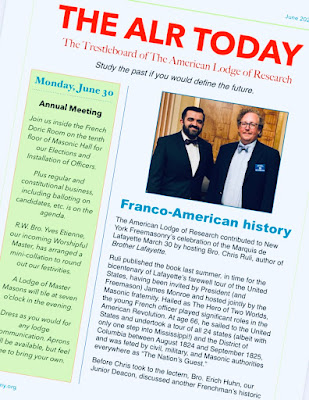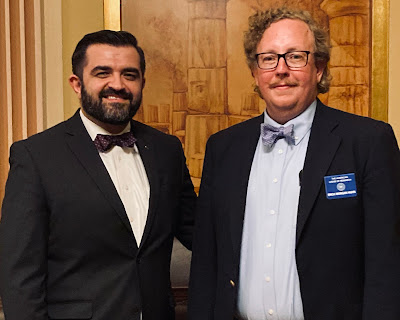 |
| From Masonry Dissected, printed London, 1730. |
Last night was the occasion of the first meeting of The American Lodge of Research since our October Stated Communication, and while it didn’t feel like four months apart, it was great to see everyone again.
This time we met jointly with Dunwoodie Lodge 863 in New Rochelle. It is tradition at The ALR to exercise our prerogative to travel about the state to hold joint communications with lodges that don’t mind having us over. We try to do it once annually, but the previous visit was in December 2022 to West Point Lodge 877.
The program last night was not research papers, but something quirky. We traveled through time and space to 1730s London to learn about the Craft rituals worked then and there. You probably know I’m talking about Masonry Dissected, the ritual exposure compiled by one Samuel Prichard. The book is what gives us our first look at a Third Degree, so it is historically very important. While it is not the first ritual exposure, it is the first to include the obligations, making it sexier than the competition. If you don’t know it, find it online and marvel at how different, yet also how similar, these early ritual renderings are to ours today. There’s no floor work—that may be found in ritual exposures from later in the eighteenth century—but the spoken content of the lectures appears in detail. We trust its accuracy because of the very successful sales of the book as proven by the number of times it was printed, meaning it was Masons themselves buying it up for use in learning their ritual.
So you’re wondering about the title of this edition of The Magpie Mason. Near the end of the Fellow-Craft’s Degree lecture, the Master of the lodge asks the candidate’s name, to which “Timothy Ridicule” is the printed reply. During the degree, the candidate, naturally, would say his own name, but Prichard is said to have been a disgruntled former Mason, so I’ll guess Timothy Ridicule is some shade thrown at the ancient accepted Order. (I’ve been using it for dinner reservations for twenty years.)
My thanks to Worshipful Master Shawn and the brethren for welcoming us to give this presentation. And special kudos to Dunwoodie’s Brother Senior Deacon for being the 1730 Worshipful Master and posing the questions of the lecture to me. And thanks also to The ALR’s officers and members for journeying out to Westchester!
The degrees back then were very brief, compared to what we today know. No lengthy orations of any kind. Those would take shape several decades later thanks to William Preston and other writers. Lectures in the eighteenth century were interactive in a question-and-answer format led by the Master of the lodge. Just like our modern Opening/Closing, which once were part of degree work. When your Master is installed and that ritual charges him to present a lecture at every meeting, he is not being told to elucidate in a monolog on any particular subject. He is, historically anyway, promising to lead the lodge in this Q&A-style recapitulation of a degree.
I have edited, modernized spelling, etc., but here is the “Fellow-Craft’s Degree”:
Q. Are you a Fellow Craft?
A. I am.
Q. Why was you made a Fellow Craft?
A. For the sake of the letter G.
Q. What does that G denote?
A. Geometry, or the fifth Science.
Q. Did you ever travel?
A: Yes, east and west.
Q. Did you ever work?
A. Yes, in the building of the Temple.
Q. Where did you receive your wages?
A. In the Middle Chamber.
Q. How came you to the Middle Chamber?
A. Through the Porch.
Q. When you came through the Porch, what did you see?
A. Two great Pillars.
Q. What are they called?
A. J. B., that is J****n and B**z.
Q. How high are they?
A. Eighteen Cubits.
Q. How much in circumference?
A. Twelve cubits.
Q. What were they adorned with?
A. Two chapiters.
Q. How high were the chapiters?
A. Five cubits.
Q. What were they adorned with?
A. Network and pomegranates.
Q. How came you to the Middle Chamber?
A. By a winding pair of stairs.
Q. How many?
A. Seven or more.
Q. Why seven or more?
A. Because seven or more make a just and perfect lodge.
Q. When you came to the door of the Middle Chamber, who did you see?
A. A Warden.
Q. What did he demand of you?
A. Three things.
Q. What were they?
A. A sign, token, and a word.
Q. How high was the door of the Middle Chamber?
A. So high that a cowan could not reach to stick a pin in.
Q. When you came to the middle, what did you see?
A. The resemblance of the letter G.
Q. What did that G denote?
A. One that’s greater than you.
Q. Who’s greater than I, that am a Free and Accepted Mason, the Master of a lodge?
A. The Grand Architect and Contriver of the Universe, or he that was taken up to the top of the pinnacle of the Holy Temple.
Q. Can you repeat the letter G?
A. I’ll do my endeavor.
The repeating the Letter G
In the midst of Solomon’s Temple there stands a G.
A letter for all to read and see;
But few there be that understand what means the letter G.
Q. My friend, if you pretend to be
of this fraternity,
You can forthwith and rightly tell
what means that letter G.
A. By sciences are brought to light
bodies of various kinds,
Which do appear to perfect sight,
but none but males shall know my mind.
Q. The Right shall.
A. If Worshipful.
Q. Both Right and Worshipful I am,
To hail you I have command,
That you forthwith let me know,
As I you may understand.
A. By letters four, and science five,
This G aright does stand,
In a due art and proportion;
You have your answer, friend.
N.B. Four letters are B**z; Fifth science Geometry.
Q. My friend, you answer well,
If right and free principles you discover,
I’ll change your name from Friend,
And henceforth call you Brother.
A. The sciences are well composed
of noble structure’s verse,
a point, a line, and an outside;
but a solid is the last.
Q. God’s good greeting be to this our happy meeting.
A. And all the Right Worshipful Brothers and Fellows.
Q. Of the Right Worshipful and Holy Lodge of St. John’s.
A. From whence I came.
Q. Greet you, greet you, greet you thrice heartily well, craving your name.
A. Timothy Ridicule.
Q. Welcome, Brother, by the grace of God.
N.B. The reason why they denominate themselves of the Holy Lodge of St. John’s is because he was the forerunner of our Savior and laid the first parallel line to the Gospel. Others do assert that our Savior Himself was accepted a Freemason whilst He was in the flesh, but how ridiculous and profane it seems, I leave to the judicious reader to consider.
The End of the Fellow Craft’s Part.
Dunwoodie meets in the Masonic Care New Rochelle campus, formerly the College of New Rochelle. Hard to believe it has been more than five years since the fraternity acquired the property, but all is not well in New Rochelle. The local politicians oppose the remaking of the campus into assisted living space—despite a number of residences for senior citizens existing in town already. I wonder what’s really on their minds.
Bro. Erich, The ALR’s Junior Deacon, and I arrived a few hours early and promptly explored some of the campus. It is frozen in time—deserted and with the abandoned accoutrements of student living evident everywhere. Beautiful stone architecture though. Castle-like Gothic style. I didn’t take any photos because the overcast day, frigid temps, and lifeless campus made a depressing scene. But while walking around and in and out of various buildings, we bumped into Past Grand Master Bill Sardone, a loyal booster of The ALR, who showed off the several spaces occupied by the Masonic Model Railroading Club.
It’s all in the early stages, but a few set-ups are working, with multiple trains running amid functioning scenery, like a Sinclair service station and pumping oil derricks. The club has accumulated more trains than it likely will be able to run, thanks to donations from around the country, but there is so much space on the campus I hope they can assemble it all in harmonious electric cycle one day soon. Send an email here to get involved.
The ALR will be back at Masonic Hall for its March 31 Stated Communication when we’ll welcome Bro. Chris Ruli, author of Brother Lafayette, to discuss the Marquis’ return visit to America in 1824-25. Also, the aforementioned Bro. Erich will tell us about Alexis de Toqueville’s thoughts on Freemasonry as gleaned from his historic tour of the United States in 1831-32.
That’s a fifth Monday. A lodge of Master Masons tiles at seven.

































































































